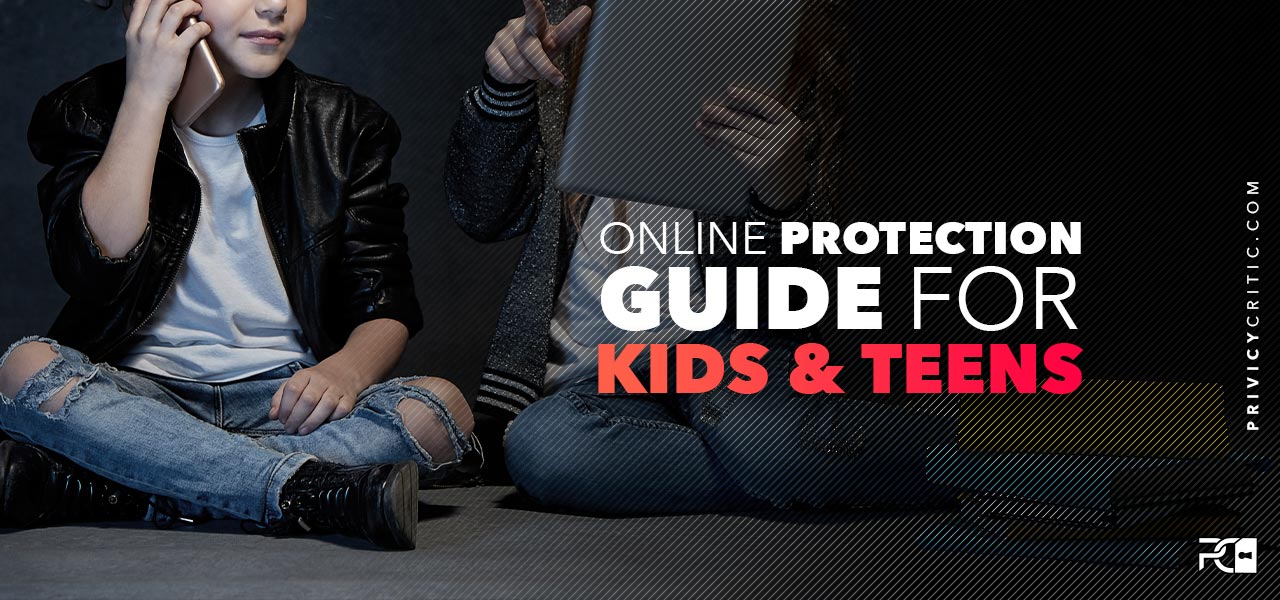
As a father of two young children, I constantly face the dilemma of whether to **limit my children’s online activities or allow them to have their freedom**. Given the rising risks of cyber threats, I find myself contemplating the idea of imposing some restrictions, given how crucial internet safety is for children, but my kids always manage to convince me otherwise. To delve deeper into the dangers that exist in the digital realm for my children and to address the worries of numerous other parents, I am putting together this guide on online safety for kids; many parents are likely to relate to my situation. Explore this guide to discover essential tips and tricks to keep your children safe online and gain peace of mind.

I will discuss the current situation, possible threats, and how to avoid them using tips, tricks, and tools. So, let’s begin with it.
Childhood and Teenage are the precious phases of my life; I would give anything to relive again. Remembering those days, when we used to spend most of the time in sports, running and chasing friends in the alley playing ‘Hide and Seek’; jumping on one leg over the chalked-drawn ‘Hopscotch.’ And, when the indoor fun was desired, ‘Atari’ and ‘Sega’ was the most favorable.
Are Gen Z or Centennials really enjoying their childhood? Think again!
Today we find more kids engage in texting and listening to songs on their PDAs, watching a kid with balloon and candy has rarely seen as it used to be, I would not blame the digital age alone, we’re letting them deeply fall in love with their smart devices. In fact, in most cases, my kids use devices more smartly than I am , however, without worrying about internet security for children and most parents alike don’t look for how to make internet child safe.
Texting, Networking, Dating, Sexting, Torrenting, Netflix and Chilling are some of the activities from the plethora of today’s cyber world that our teens are involved in – thanks to the Internet.
So, Where’re Parents?
Thanks to the modern age, we as parents, don’t mind giving our one-year-old a mobile phone to listen to songs or play a game – just for the sake of our convenience. What happened then? Kids got a permanent possession of a mobile phone as they turn 6 or 7 with no thought about internet security for children; believe me, I am not exaggerating; you’ll be convinced soon.
Neilsen’s First Quarter Mobile & Kids Survey
To find out, what are parents’ concerns and reasons behind handing-over a gadget that can be harmful for their kids, Nielsen – a leading global information & measurement company, conducted a survey.
Methodology of the Survey
Nielsen’s Mobile Kids Report gathered a sample of 4,646 parents with kids between the ages of 6-12 years old. The sample was identified through Nielsen’s Mobile Insights Survey.
What, Why, How, Parents Think – Questions, Concerns and Finding of the Nielsen’s Survey
Why parents get their kids smartphone before they turn 13?
Following were the results:
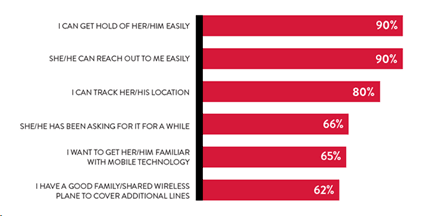
The survey also gathered a set of data to check, at what age kids get a smartphone and the results were:
- At Age 8 – 16% of results were positive
- At Age 9 – 22% results were positive
- At Age 10 – 34% results were positive
- At Age 11 – 44% results were positive
- At Age 12 – 56% results were positive
The report also showed that 72% of the kids have the same mobile plan as their parents and 94% of them have access to all wireless services like messaging, snapping and the internet.
What Are the Top Activities of Kids After getting a Phone?
When asked to the parents regarding the top activities performed by the Kids – Here’s what they have replied:
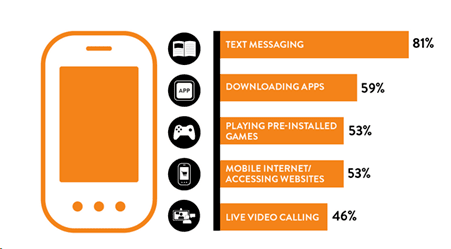
Most of the time a kid of ages between 6-12, uses his or her mobile to text to friends and family; the results reflect text messaging is the most favorite activity among kids.
The survey showed one thing clearly. It’s not the kids and teens, it’s you and I – parents – who are pushing them in a world where they can be harassed, bullied, scammed, mentally tortured, and threatened, by handing over a toy that they don’t know how to use it.
Before passing any final judgment, let’s find out how a kid is legally protected in the cyber world so you can know what to do when keeping your child safe online.
What Are the International Legal Laws Protecting Kids and Teens Online?
Online technologies expose kids and teens to potential dangers like illegal downloads, viruses, harassment, bullying, sexual exploitation, blackmailing and worst of all the misuse of personal data. No silver bullet has yet been designed to protect kids and teens online.
Keeping children safe online is a global issue which needs greater consideration from all segments of life; each one of us, including our kids, are also supposed to join hands for this cause.
Recognizing the great danger that our little champs are facing in cyberspace, the international community has passed some laws to protect kids and teens from any harm online. Some of are:
The Convention on the Rights of the Child (CRC) – 1989
The law recognizes the human rights of all children in all parts of the world including child protection from any harm or abuse in cyberspace. It is globally recognized and implemented in many regions of the world.
UNICEF Principles for Child Protection
UNICEF is a globally recognized organization working for the welfare of Kids around the world, especially under-developing countries. The principles states the following when it comes to Children rights in the cyber world.
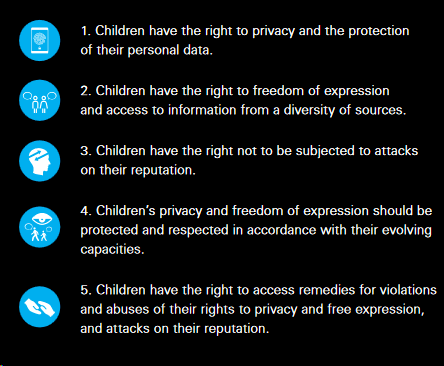
Children’s Online Privacy Protection Laws (COPPA) – 1998
COPPA – The law comes into effect on April 21, 2000. It protects the privacy rights of Children for sharing personal information especially kids under 13 years age and kids with disabilities.
According to this law, children under 13 years of age and children with disabilities can share information with websites and social media platforms with parents permission.
Children’s Internet Protection Act (CIPA) – 2000
The Children’s Internet Protection Act (CIPA) was passed by Congress in 2000. The law was designed to address concerns about children’s access to offensive or harmful content online. CIPA imposes requirements on educational institutes that receive discounts for Internet access through the E-rate program. It is a program that makes certain communications services and products more affordable for eligible schools and libraries.
Although the laws and acts are there to protect our kids online, still they are weaker if we, as parents don’t do our job. Let’s move ahead and discuss the rapidly increasing usage of the internet in our Children’s lives.
Our Kids and Teens are Getting More Dependent on Technology – Aren’t They?
Technological advancements overrun the world and turning it into a cyber globe. Technologies are becoming our needs; Smartphones, Smart Gadgets, TVs, Laptops, VoIP, Streaming channels, Torrenting and everything in between, becoming our lifelines.
A 3 years old kid knows how to play a game on a mobile phone or tablet, but he can’t do the blocks. A 7 years old introvert has hundreds of friends – NOT IN REAL BUT ON FACEBOOK. Technology has become the toy for our kids today, but is it the right toy for them? Who is going to decide? while most parents give less focus to keeping children safe online or how to make internet child safe.
These all devices and platforms were introduced to make our lives more comfortable and convenient, but these technologies are bringing some unfortunate consequences for our children; as the saying goes, too much of something is wrong. We have made our kids too much dependent on these technologies; I would instead call it a pit of snakes.
Use of Technology – Kids and Teens
Information and Communication Technologies (ICTs) have changed the way we interact with others, changed the way we access information, express our feelings, post and share content.; so does our kids. It is not wrong to say that for today’s generation, the internet has become a virtual first-aid box for our kids; they connect to feel secure about, to have fun, to relax, to earn knowledge, to make friends, to communicate with unknown people, and whatnot.
What they don’t know is – how this first-aid is becoming a place to be harassed mentally and sexually; a place to get bullied; a place to be scammed; a place to be blackmailed, a place to be robbed and a place for anything of horrible one can think of. Parents needs to master how to make internet child safe and internet security for children.
According to a research conducted by Dr. Brent Conrad – Clinical Psychologist for TechAddiction, following are some horrifying stats:
- The average age where a kid start watching TV is 9 months
- After TV, the most common attraction for kids in technology is playing games. In the last couple of years, the percentage has rapidly increased.
- 81% Kids of 2 to 4 years of age have played video games on console, and 90% have used a computer or laptop for this purpose.
- 10% of kids under the age of 8 have used educational software, and 6% used a laptop for homework.
- 11% of children under eight years old use a cell phone, iPod, or iPad / tablet.
- Listening to music start from a very young age even when a kid is just a few months old.
- The average time of listening to music for a kid a year old is 39 minutes, for kids at ages 2 to 4 is 30 minutes, and for kids ages, 5 to 8 is 23 minutes.
- By the age of 8, 96% of kids have watched TV, 90% have used a laptop, 81% have played video games on consoles.
- 60% have used apps on portable devices like a cellphone, gaming gadget, iPod or tablet.
When a kid moves into teenage, the usage of mobile and the internet gets higher. As per a researched by PewInternet,
- 95% of teens in America owns a Smartphone.
- 45% of those teens now say they are online on a near-constant basis.
According to Statista – The Static Portal, here are some of the stats from 2018:
The viewing habits of teens are entirely different than of young kids — an increasing number of teens watching TV online through on-demand subscription.
- 38% of teens in America consumed a daily dose of online TV from Netflix
- 33% of teens from other channels like YouTube, Vimeo, etc.
Social media and online gaming are also one of the essential aspects of teens life nowadays.
- American teens spend almost 180 minutes (3 hrs) daily on social media.
- An average American teen spends 2 hrs playing games on console or smartphone.
- The percentage of playing games is higher in boys which are 64% than that of girls.
According to the Center’s Survey of U.S. teens conducted March 7-April 10, 2018, there is a massive change in the usage of social media among teens compared to the last survey conducted back in 2015. The numbers stated the following results:
- The popularity of Facebook has decreased from 82% to 71%
- Instagram usage has increased from 24% to 54% over the years.
- 41% American teens has now started using Snapchat.
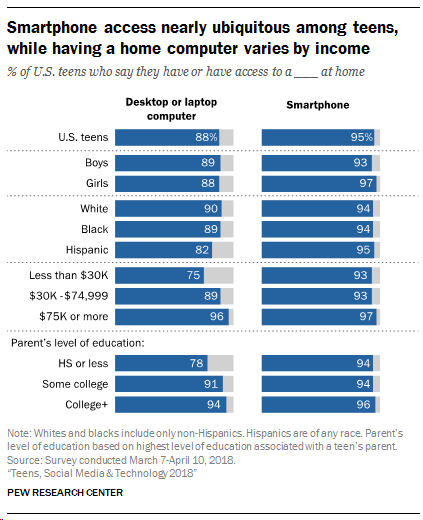
In the UK, the situation is not different.
- 60% of kids ages between 12 to 15 owns a smartphone.
- 54% kids ages between 5 to 7 owns a tablet.
Is Technology Harming Our Kids and Teens? A Word Answer is YES!
From the beginning of the guide, I have been screaming that technology is neither all-good nor all-bad; it has many benefits but has some aspects that are damaging the lives of our little champs disastrously.
Here are some of the threats that our kids might be facing in the cyber world.
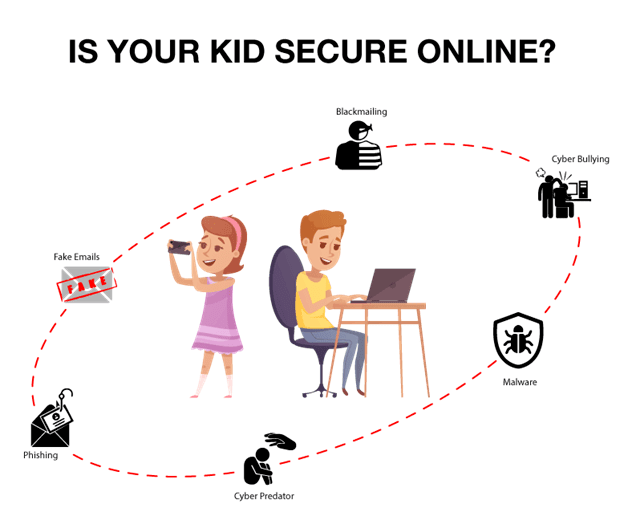
Cyberbullying – A Lifelong Scar on Kid’s Personality
Cyberbullying refers to making a kid feel pity about his or herself by calling him/her names, mocking their physical or mental appearance, their capabilities, disabilities, race, religion, family and parents, clothes, etc.
According to BroadbandSearch.net, 77% of teens who are active on social media have ignored bullying they’ve encountered. One third of the kids have been victims of cyberbullying themselves which means it is important to understand how to make internet child safe or internet security for children.
Social media has become a virtual playground and it is the place where most cyberbullying occurs. Cyberbullying can be anything from humiliation to fear, and in extreme cases, it can take the kid to the suicidal stage.
There are many stories available to learn a lesson on why internet security for kids is important. I am quoting some to show the intensity of this one act which is a joke for someone, but a matter of life and death for the other.
Abbie Ellison – a teen from Idaho, America, told her heart-ranching story to LocalNews8. She said:
“I’ve overdosed, I’ve tried hanging myself, and cutting myself to the point where I needed stitches,”
“People decided to gang up on me and call me a whore,”
“It got to the point where in December I had tried overdosing because it had gotten so bad and I felt so bad, and I was in treatment for seven months and when I came home it had continued over since I had been gone, but it also started out with new people that I didn’t even know.”
A therapist suggested that bullies have issues themselves and they tried to hide behind these screens. He also said that the worst and most immediate impact of cyberbullying is depression.
Do you want your kid to be cyberbullied? Do you prefer paying thousands of dollars to a therapist to make your kid smile again? Think about it for a second!
Complete Interview of Abbie Ellison.
The best foundation for protecting against cyberbullying is to be comfortable talking to your children about what is going on in their lives, and how to stand up to bullies.
Cyber Predators – Kill Me, But Don’t Abuse Me
Child molestation is not limited to physical state only. There are sexual predators stalking kids and teens on the internet, taking advantage of a child’s innocence, making the kid to trust them, ultimately luring them into physical encounters.
Social media is the safest and opportunity-filled platform for cyber predators who not only use the innocence of kids and teens but also take advantage of their imagination. There’s a phrase most commonly used “Let’s play pretend” both on social media and online gaming as a hook to trap a kid.
- 1 in 5 teens in America received an unwanted sexual solicitation via social media or VoIP platforms per day.
Solicitation refers to a request engaging in sexual acts or talks.
- The most shocking fact about child sexual exploitation on the internet is that 40% of the victims were boys ages from 11 to 15.
- Sexual Predators are usually in between 18 to 55+ of age. They can be teenagers themselves in most cases.
- There are 799,041 Registered Sex Offenders in the United States.
- 33% of teens are Facebook friends with other people they have not met in person who potentially can be a sex offender.
There are guidelines for safeguarding the kids against predators by the FBI. But, these guidelines are useless if you do not communicate it properly to your kids. The best protection is communication with your kid.
Our advice:
BETTER SAFE, THAN SORRY
Posting Private Information – Set Virtual Boundaries for Kids
Children do not know of boundaries when it comes to posting content online. Your six-year kid can post anything he has, say anything to anyone he is talking to, post pictures of your home without making it private.
Being hilarious is teens’ things, and to prove it, they keep posting awkward family moments on social platforms which is weird sometimes. The parents must set some boundaries for kids.
Provide cyber safety tips for kids. Don’t stalk and stop them, communicate them the public boundaries.
Phishing – The Most Complicated Online Threat
Phishing is one of the most unpredictable and complicated ways of online threats. Hackers sent you an email with malicious links or attachments, for example “Hey – You might like this” or “Exclusive discount just for you” or “You won 500,000”, just to make you click on the link.
The same technique is used via text messages as well, which is called smishing. Phishing emails can pop-up anytime. Let’s say you have given your laptop to your 6 year old kid to watch a cartoon on YouTube and suddenly a glowing message in ‘Red and Blue’ appears. As a natural instinct, your kid will click on it. As he has no knowledge of what it is, and how far will it infect your hardware.
In the worst cases, you may lose all your date, personal details, financial documents and much more, to a hacker. These attacks can also be directed via adult websites. The best way to avoid phishing attacks is by educating your kid not to click on any link or text which is not from a known source. This is another way to ensure internet safety for children.
Scams – When Things are Too Good to be True
Kids and Teens might not fall for Nigerian billionaire giving away his millions of dollars to random strangers, but they might be interested if something says “Free Game Subscription.” Teens are the easiest targets compared to younger kids when it comes to scamming as they are least bother about giving away personal information, this is why it is imperative to provide internet safety for kids — hackers target website which potential visitors are teens.
The best practice to save yourself is by avoiding any such offer that sounds too good to be true.
Malware – Your Worst Nightmare
Cybercriminals design software that is installed in the device without any permission or knowledge of the victim. Malware aims to take control of the invention and steal personal information. Kids are generally not carful about this personal data on the internet and that is why parents should be responsible for keeping children safe online or understanding internet safety for kids.
Most common ways cybercriminal use to trap kids and teens to download malware is via gaming apps. Android is one of the most vulnerable operating systems, and apps in the Google Play store are a key source to malware. Recently, Android has removed 22 apps from Play Store after a security company ‘Sophos’ reported them a source of fraud by hackers. 90% of these 22 apps are gaming apps for kids and teens. Some of these apps are:
- Snake Attack
- Math Solver
- Zombie Killer
- Space Rocket
- Table Soccer
- Cliff Diver
- Box Stack
- Jelly slice
One of the best ways of providing cyber safety for kids is by making them aware of the threats is the best practice, but antivirus software and other security tools can help keep your kids safe from malware. Many security tools also include specific parental control like Antivirus that can help you set a secure limit for your kids’ online activities.
Careless Posts – The Ghosts of Your Pasts
Your keyboard has a delete key, but the internet hasn’t.
Everything posted online, even if deleted, remains there forever. The internet has no delete option; whatever you child post online today, can come back and haunt his or her future.
Let’s take an example here:
Google knows everything about your kid everything, your kid search online is stored on Google, whatever app is downloading, the places of your little champ fav places, and whatnot. All these are in sync with all the Google sublets; even the WhatsApp backup is also connected with Google.
Everything we do and post on the cyberspace, it remains forever; Google knows us more than our own selves.
Kids are least bother about the future. They have no sense of how a future boss – or a future spouse might respond to the amusing images posted today.
It is very important to tell the kids and teens to understand that they might change how they wish to portray themselves in the future, but the internet won’t let them. This should be one of your strategies for keeping your child safe online
There are many case studies available on the internet, where you can read that how the use of the internet has spoiled a kid’s or teen’s life to the extent that they ended up committing suicide. Psychiatrist and researchers agree that the internet and media have poorly impacted on kids health and mental stability. The average screen time that should not extend from 2 hours a day has reached to 7 to 8 hours a day.
Predators are trapping kids and teens to exploit them sexually. Bullies are mocking and abusing other kids and teens to make them feel bad about themselves, and it leads to severe depression. Worst of all, hackers are trapping children to get a hold on their parent’s financial information like credit card number, id, and password to online banking.
How to avoid these threats? What should a parent do? What should a teen learn? Let’s learn together and help each other to pull our kids from cyber threats.
What You And Your Kid Needs to Learn to Stay Safe Online?
You have to use age-appropriate online safety for kids tips. They also need to be age-specific, timely delivery, culturally sensitive and match the values and laws of the society in which the kid or teen is living in. To have a clear picture, I have identified three principal age groupings of young Internet users.
Hence the keeping children safe online guidelines can be seen as tips which help you keep your cyber world safe. However, it is important to mention that every child is different and need individual attention. A single kid of particular age group might need guidelines from another age group. Negligence should not be taken for granted when you aim to provide internet security for kids. This begs the question, how do you protect kids online?
Children from age 5 to 7
- Type of Encounter with Technology: Basic or First time encounter
- Device and Platforms Used: Usually limited to TV, Games on Mobile phone, Cartoons on Tablet and Gaming Consoles
- Harmful Risks Involved: Encounter to explicit content, bullying, malware app downloaded, sexual harassment and physical abuse
What is most needed?
- Constant and close supervision of parents.
- Better use parental controls.
- Restrict their access to explicit content.
Children from age 8 to 12
- Type of Encounter with Technology: Intermediate level encounter including the usage of the Internet
- Device and Platforms Used: Involved everything from TV to the internet on all devices
- Harmful Risks Involved: Encounter to explicit content, bullying, malware app downloaded, blackmailing, exposing personal details, fall for scams, sexual harassment and physical abuse
What is most needed?
- It is recommended to communicate with the kids and teens to make them understand the haphazard and disadvantages of online threats.
- Give them the knowledge about online security.
- Close supervision is needed for this age group too.
Children from age 13 and Above
- Type of Encounter with Technology: Advanced level encounter including the usage of the Internet + Social Media + Adult content.
- Device and Platforms Used: Involved everything from TV to the internet on all devices
- Harmful Risks Involved: Encounter to explicit content, bullying, malware app downloaded, blackmailing, exposing personal details, fall for scams, sexual harassment and physical abuse
What is most needed?
- Communicate with the teens.
- Educate them about being careful and not trusting anyone on the internet.
- Minimal supervision is needed for this age group too.
Communicate ‘SMART RULES’ to Your Lil Champs
S = Set your Limits
M = Meeting online friends in real
A = Accepting requests
R = React
T = Teach your Kid to Tell someone
Using the internet is fun, but how unpleasant this fun could be, this is we’ve to learn. Enjoy while surfing the internet, but be safe.
S
Set Limits for Kids and Teens
- Take your child’s privacy seriously and also teach them to do the same
- On social media, always limit privacy setting and show the same to your kids
- Ask your kids and teens to think twice before posting anything online
- Teach your teens to be critical about things on the internet. What seems fine or right, may be bad or harmful.
Never accept harassment and bullying from anyone. Teach your child how to report a person or profile on different platforms
M
Meeting Online Friends in Person
- These online friendships can be a trap; these relationships mostly end up in child abuse, sexual assaults, bullying, and many others.
- Teach your kids to always be careful while selecting friends and to share the details with parents.
- Communicate your kids to think twice before meeting an online friend in person. Always ask them to take your permission before meeting a friend or it is way safer if your tag along with them.
Imitating someone online is easier and your kids might not identified it.
A
Accepting Requests
- Never accept request who is not your friend or relative or friend’s of friend.
- Accepting requests, emails and messages from unknown people or untrusted resources can be dangerous.
R
React
- Ask your kids to protect themselves from upsetting or distressing content.
- Tell your kids that if they encounter anything unusual or bothersome, come directly to you and inform you.
- Tell them to react to any harassment or bullying immediately
- Teach your kids to ignore bad behavior and leave unpleasant conversations or sites with inappropriate content.
T
Teach Your Kid
- Tell your kids to block anyone approaching using rude, intruding or threatening messages or comments.
- If someone sends anything disturbing in text or visual, ask your kids to save it so it can be reported.
- Alert your kids to always report any stranger who likes to talk about sex or anything related to sex.
- If any stranger or even relative ask for sexual images of your kids, ask them to report it immediately to you.
Teaching your kids the best practices, but not keeping your devices secure is like having half tablet to cure your disease when one tablet is prescribed.
Here are some of the more handy tips for parents to keep their kids safe online.
Parents – Be Alert, Your Kid is Not Safe Online
Always Use Firewall and Other Security Tools
Install firewall and antivirus software on all devices that your kids use daily. Remember to keep them up to date!
- Antivirus:
Antivirus is one of the best and most essential security tools that keeps your device protected from malware and phishing to a great extent. It also comes with ‘Parental Control’ which help parents to restrict their kids’ accessibility to certain websites, apps; even keywords could also be restricted to control the search.
- VPN:
VPN is another most secure and must-have security tool that helps you to keep your home network protected from scammers, hackers, and eavesdroppers. Using a VPN helps you to keep your children anonymous on the internet so that predators and scammers cannot track their activities.
It also helps you to provide digital citizenship of many countries to your kids so they can bypass geo-restrictions and access content from anywhere they want; but don’t forget to keep your eyes on.
A VPN also protect your devices from DDoS attacks; isn’t great for your lil gaming-nerds.
Always keep your Devices Updated
Learn about your computer’s operating system (like Windows, Linux, etc.) and especially about how to patch it and keep it up to date. Every update fix bugs from the previous versions.
Know your Device
A part of keeping children safe online is to get familiar with the devices you hand over to your kids and know how it works. If the device starts malfunctioning or performs unusual commands, you can act immediately.
Keep an Eye on Your Kid’s Friend List and Browsing History
Snooping is not ethical in most cases, but when it comes to keeping your kids safe from predators and scammers, it’s completely ethical and highly-needed. Always keep a close eye on your kid’s online activities, especially if they are under 13 years of age.
Communicate, Teach and Train
Technology is evolving day by day; keeping pace with new advancement is very important. It can only happen if you keep yourself updated with what’s happening in the technology world.
We at PrivacyCritic keep informing and sharing the latest events, happenings, trends, tips, and how-to to keep you up-to-date.
I hope I have cleared a lot of concern as being a parent myself; I know how difficult it has become to keep our kids safe online. But if we act responsibly, and teach the same to our kids, believe me, threats think before harming us.
Subscribe to our blog for our upcoming guides and if you’ve something on your mind (a concern, tip, feedback, opinion, advice) about kids’ online security, feel free to share with us in our comment section below.

